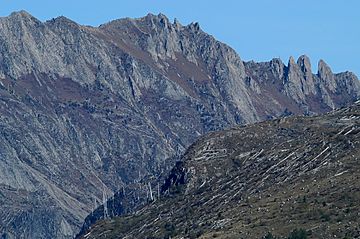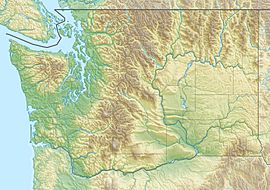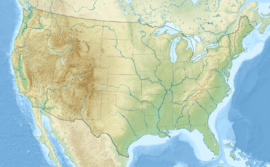Mount Whittier (Washington) facts for kids
Quick facts for kids Mount Whittier |
|
|---|---|

West aspect
|
|
| Highest point | |
| Elevation | 5,883 ft (1,793 m) |
| Prominence | 1,843 ft (562 m) |
| Isolation | 9.19 mi (14.79 km) |
| Parent peak | Mount St. Helens (8,333 ft) |
| Geography | |
| Location | Mount St. Helens National Volcanic Monument Skamania County, Washington, U.S. |
| Parent range | Cascade Range |
| Topo map | USGS Spirit Lake West |
| Geology | |
| Type of rock | granodiorite |
| Volcanic arc | Cascade Volcanic Arc |
| Climbing | |
| Easiest route | exposed class 3 scrambling |
Mount Whittier is a tall mountain in Washington state. It stands 5,883 feet (1,793 meters) high. You can find it in the Mount St. Helens National Volcanic Monument. This area is part of the Gifford Pinchot National Forest in Skamania County.
Mount Whittier is part of the Cascade Range. It's about 2 miles (3.2 km) north of Spirit Lake. It is also 1.7 miles (2.7 km) northeast of The Dome. Its closest neighbor is Mount Margaret, which is 0.93 miles (1.5 km) to the south. The closest taller mountain is Mount St. Helens, about 9 miles (14 km) south. Mount Whittier is the second-highest peak near Mount St. Helens. Even though it's not the tallest, it rises sharply. The summit climbs 2,000 feet (610 meters) above the Coldwater Creek valley. Water from Mount Whittier flows into streams that feed the North Fork Toutle River.
Contents
How Mount Whittier Was Formed
Ancient Earth Movements
The Cascade Range began forming millions of years ago. This was during the late Eocene Epoch. Huge geological events shaped the land. They created the varied mountains and valleys we see today. These changes also led to different climates across the range.
Ice Ages and Volcanoes
During the Pleistocene period, over two million years ago, glaciers moved across the land. They carved and shaped the mountains many times. The North American Plate is slowly moving over the Pacific Plate. This movement caused volcanoes to erupt. These eruptions created the rocks and peaks of the Cascades.
Mount St. Helens' Impact
The big 1980 eruption of Mount St. Helens affected Mount Whittier. A powerful side blast from the volcano hit Mount Whittier. This blast stripped away all the plants from its slopes. Because Mount St. Helens is so close, volcanic ash is common here. Mount Whittier and nearby Minnie Peak are made of strong rock called granodiorite. This rock formed from molten material that pushed into older rocks about 20 million years ago.
Weather and Climate at Mount Whittier
Understanding the Climate Zone
Mount Whittier is in a marine west coast climate zone. This means it gets a lot of moisture from the ocean. Most weather systems come from the Pacific Ocean. They travel northeast towards the Cascade Mountains.
How Mountains Affect Weather
As these weather systems approach the mountains, they are forced upwards. This process is called Orographic lift. When the air rises, it cools down. This causes the moisture in the air to fall as rain or snow. So, the western side of the Cascades gets a lot of precipitation. This is especially true in winter, when it snows a lot.
Best Time to Visit
During winter, the weather is often cloudy. But in summer, high-pressure systems build over the Pacific Ocean. These systems often bring clear skies. This means there is little or no cloud cover in summer. The months of July, August, and September usually have the best weather. This is the best time to see or climb Mount Whittier.



